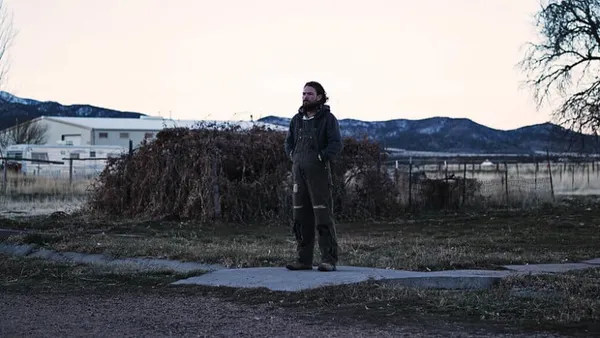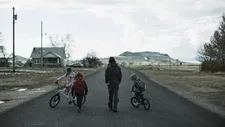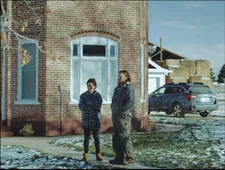 |
| Clayne Crawford: 'What the joy was, is, I saw the opportunities to play so many different sides of a human being, which you rarely get in a film' |
Although The Killing Of Two Lovers is Robert Machoian’s film debut, there’s a maturity about this intimate character study of a family man who finds himself on the edge, not just in terms of its tight storytelling – mirrored by the use for most of the running time by the 4:3 ratio – but also the craft. David (Clayne Crawford) is struggling to cope with the relationship break he and his wife Nikki (Sepideh Moaffi) are taking, not just because it means he spends less time with his kids but because they live in a fishbowl of a town where emotions are magnified, a tension that grows through the film, with David’s bottled up emotions threaten to blow as he finds himself in competition with a rival for Nikki’s affections (Chris Coy).
I caught up with Crawford – who had most recently been working chiefly in television, in ex-con drama Rectify and playing Martin Riggs in two seasons of Lethal Weapon, before he was fired after alleged clashes on set. He not only proves compelling in the lead role but also produced the The Killing Of Two Lovers. We began by talking about the setting in rural Utah - a long way from the Network TV backdrops or the usual cityscapes of film debuts.
“With technology, the way the game has changed, you can go make a movie for very little,” says Crawford. “Because the cameras are so sophisticated, you don't need 10 lights and a big grip truck. So for me, it was really all about the prep work, you know, and it made it nice, because when you finance the film, it was just Robert and I kind of making these decisions.
“So we tried to be as practical as we could. And we're also fortunate that Robert is a professor of Brigham Young University, so we had resources that he had access to, along with his - that was our crew. They were lovely and wonderful, and here's the best part, when you get outside of New York and LA everyone loves making films, and they're grateful to make films and it's not just about making a big pay cheque and if it's going to have a big billboard and a big release. It's like, let's just do the best we can. So it actually removes a lot of the pressure, and a lot of the stress and the strain.
 |
| Clayne Crawford: 'Robert handed me the script in October, we talked about doing it in August, he gave me a script in October, we were on set by December 1' |
“Robert handed me the script in October, we talked about doing it in August, he gave me a script in October, we were on set by December 1. And never one time when we stressed never one time was it frustrating - we put all the elements together, we got our cast there, and then just immersed ourselves in the process.” Machoian and Crawford have known each other since they met at Sundance in 2010, when the director brought his short Charlie And The Rabbit to the festival and Crawford was starring in Midnight film The Perfect Host.
Crawford adds: “He sent me a script that year and I fell in love with it and no one would help us make it. I booked Rectify and then I was busy. Right when I was wrapping Rectify, we started to shoot this film that we wanted to make. And, literally, while we were in the middle of shooting in Alabama with the same kids that we shot with in Utah, I got the call for Lethal Weapon. Literally, ’Like we need you by next Thursday’. They had not cast the role, I'd passed on it, like, 50 times and they offered me more money that can say no to. And we scrapped it - Robert went home I went to shoot. And then when I got canned, I was like, ‘Look, let's take this money. Let's just go do it’. Oh, wow.”
So, was it a happy ending for him, then?
“It was the greatest because it backed me into a corner. I was so freaked out. I was like, ‘What am I doing? And why did I get into this industry?’ And I felt like I'd made it to the top. And I was like No, no, no. So then I just did what I'd done after Swimf@n and A Walk To Remember when I was not quite satisfied from those processes - and came to Sundance. I said, ‘Let's take this money. Let's not worry about finding investors. And let's finally go make something the way we want to make it’.”
He adds: “I was gaining frustration, because working on rectify with Ray McKinnon, his quality control was so incredible. And he was so hands on that when I got to the studio level, and I realised that it had to pass to 50 different hands, there was no way to maintain the quality of the piece.”
He admits that being able to be hands on himself as producer as well as the star of The Killing Of Two Lovers was a welcome change and gave him full investment in the project in a way that simply acting wouldn’t. “I'm a little bit of a control freak, right?” he says “So to know that Robert and I could do it together. And yeah, we had skin in the game, but not only for us, because we took no money for this film, obviously, we put it all into the piece - but we gave percentages of the movie, not bullshit percentages, real percentages to our actors, to our camera operator so that we were a team making a movie and if we succeeded, we all succeeded together. And that's so rare in this industry.”
Crawford says The Killing Of Two Lovers stemmed from he and Machoian being “fascinated with masculinity in America” and “what happens when a mother and wife starts seeing a new man”. He adds: “We had the short where this father comes to pick up his children and in this interaction, there becomes an altercation with the new boyfriend, and the father gets his ass beat. And we were curious how that would affect the children if they saw their hero kind of fall. And would that draw them closer to the boyfriend? So we were just curious about that dynamic. And it was about six pages, eight pages.
“And I said, ‘Robert, I really think we can build on this dynamic of this relationship. Do you think you could turn this into a feature?’ This was August. He goes, ‘Give me a couple months’. So he drove to Kanosh, Utah, he had a friend who owned an artist loft down there, a painter. And he goes, look, there's population 350, there's nothing within 45 miles of any direction. It's a bubble. Well, while Robert’s sitting, writing in this town, he says, ‘This is the location’. And then he begins to write for this town. He called me and said, ‘Buddy, this is we're going to shoot this movie. It's a fishbowl. And what an interesting way to kind of tell this family drama with everyone kind of looking in’.
The fishbowl element comes across strongly in the film when David finds himself saying hello to people no matter what his internal emotional state – going through the motions of small-town life whether he wants to or not. The role, like everything in the film, feels stripped to a bare intensity, as David grapples with his conflicting emotions about his family and his future - something that Crawford welcomed.
 |
| Clayne Crawford: I said, ‘Let's take this money. Let's not worry about finding investors. And let's finally go make something the way we want to make it’ |
“What the joy was, is, I saw the opportunities to play so many different sides of a human being, which you rarely get in a film. Robert presented these opportunities to see David with his children, which was going to be a whole other side, And then his relationship with his Nikki and her boyfriend and with his dad. I thought, ‘Man, what a great chance for us to make something really interesting’. And I sent it to a couple of actors, Chris Coy being the first because I've worked with him on Lethal and I was just so impressed with his approach to the work and he loved it. And yeah, then we jumped in. I Rarely do you see something that appears to be masculine, but it's extremely vulnerable. And it was such an unusual dynamic within David.”
One of the most striking elements of the film is its bold sound design from Copenhagen-based Peter Albrechtsen, which mirrors David’s increasingly pressured mental state with its creaks and groans sounding like a ship’s hull under pressure.
“We knew that we wanted Peter, because Robert had worked with Peter on The Minors. We weren't quite sure what he was going to bring us. But we said, ‘Look, don't want it to be a traditional score. We want the sound design to become the scoring and we want it to be a reflection of his mental state. And we'd like it to be uncomfortable, if that's possible. And that's really all we said. And we just showed him the film. And then he brought those coils in the click, click, click.”
So how did Crawford feel when he looked at the performance he had done overlaid with the emotion of the sound design?
“What I felt was two things. First, an incredible amount of enthusiasm that someone who had not been on the journey with us from day one took that much creative liberty to explore things without any fear, and that he was willing to challenge the piece. We were extremely excited that he saw that because that's what was in our head and we didn't know how to articulate it. So yes, the hair stood up on the back of our necks instantly and we felt uncomfortable with the sound design. I think that was the first thing, it was so jolting. And we knew we had something. I flew Robert to Copenhagen, and he and Peter started working, really kind of figuring out the details of it. But no, we had no idea it blew us away and it elevated the piece in such an incredible way that I hope we get to work with Peter for the rest of our careers.”
Crawford’s performance has a tinder box feel to it, as David tries to repress his emotions. “I can't help but continue to go back to Rectify,” he says, “because it was such a growth for me as an artist. Ray was so specific on how he kind of worked with our characters, in showing me that it's what's underneath that's interesting, and that we as humans want to cover that emotion with something else. But it slowly begins to bleed through. And that's what I played when I was playing Teddy. So I was able to bring a lot of that technique into this character, which it becomes a playground, you know, you can't come in with any ideas. You have to really feel the emotion of what's happening, and then try to cover it throughout the scene. So it was just it was a joy.”
The family dynamic in the film is also bolstered by the fact that Machoian’s own children play three of the kids in the film, so they brought their existing relationships to it.
“You're right. What’s incredible about shooting in a small town like Kanosh, where there are no hotels, there are no restaurants, there's no grocery store, there's a mercantile and a gas station, is we became a family, we ate together, we stayed in the houses together. So there were no distractions outside of making the film. So when we were not actually in front of the camera, we were reading lines, and we were blocking because there's some quite long takes so the choreography is extremely important within the lines, because what we didn't want to do was improv. Robert had created such an incredible structure with the dialogue that it was constantly building on itself, so we didn't want to miss any of those beats.”
So does Crawford see himself doing more television in the future or staying more within a film environment? “I think I just like I like working on quality products, right, quality films and television. But the thing is, now there's not much difference between the two. If anything, TV has become this beautiful playground where you can explore the characters and all of the characters within the story equally. But I have no desire to ever go back to network. I went and took a bite of the apple, as it were, and realised that’s certainly not for me. As much as it's nice making millions and millions of dollars over a very short period of time. I've been doing this for 20 years and hit 41 - I want to be fulfilled. And that's why I moved out of LA. I bought a little farm in Alabama so that I didn't have to make those decisions that I didn't support as an artist."
In fact, since this interview was taken – back at Sundance 2019 – Crawford and Machoian have made another feature together, The Integrity of Joseph Chambers, another consideration of modern masculinity about a family man who must learn to hunt in order to provide for his family, which is currently in post-production.
The Killing Of Two Lovers is in cinemas and streaming on Curzon Home Cinema from June 4





















